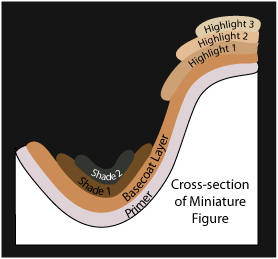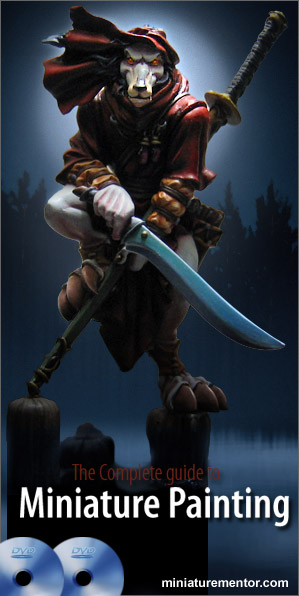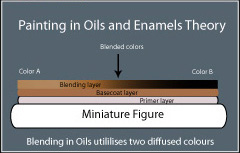Painting Basics-How it works
Miniature Painting in Oils and AcrylicsMiniature painting in general comes in 3 different mediums, acrylics, oils and enamels. The first two mediums will be widely discussed in this website because they are the two mediums I am used to. Mixed mediums are also widely used by modellers today. Sometimes I will use oils to paint my miniature heads. I decided to include a short article on this topic for those who would like to understand the basic fundamentals and theories of painting in acrylics and oils. I remembered how I dived into each medium and self taught myself by reading from forums, books and articles. It took me a while to fully understand how each medium behave and a little practice before I could utilise each medium to my advantage. I hope after reading these points, it would make it simpler for beginners to � handle� each medium and make it their own. Oils Theory
The down side of wet oil paint is that it attracts dust particles to it and can damage the paintwork. The up side to oil paints is that due to its longer drying time, you can adjust the colors. Always paint and store painted miniatures in dust free areas. Storage like a glass cabinet or display cases are good. Oil paints can get very messy so have a napkin or towel ready and always start over if the blending is not up to your expectation. When oil painting a figure a very thin layer of oil paint is being used. This will ensure the details of the model is not lost and a smooth finish. During blending or stippling make sure to unload your brush frequently onto a towel to remove excess oil paint. This action will ensure that the figure is not clogged up with too much oil paint. |
Acrylics Theory

Acrylics blending utilises overlapping layers. |
Acrylics PaintsAcrylics is extremely versatile, fast-drying paints, and can be used straight from the tube like oils or thinned with water or a medium and used like watercolours. If applied thickly � either straight from the tube or with very little water added or if mixed with a little white, all acrylic colours can be opaque. If diluted, they can be used like watercolours or for airbrushing. Acrylic paints are easy to clean up using soap and water. Only mix small amounts of paint at a time, use a palette with a cover, and cover unused paint when you leave your work. |
Acrylic paints are fast drying and can be thinned with water and acrylic medium to apply very fine layers. Use thin coats to accent surface detail. Thick coats of paint will fill in the details and lower your opportunities to add highlighting washes.Acrylic paints are ideal for situations where you want to apply washes to highlight miniature details.
Very thin yet opaque coats can be used to create the base, then detail washes can be applied over the base coats without any danger of blending or bleeding. Do not over thin acrylic paints with water, the paint will become weak.
Use a mix of water and acrylic medium. Finally it is most advisable to add acrylics retarder to extend the drying time of the acrylics in your colour palette.
Ratio of how many parts paint to how many parts water
1:1 Minimum rate of dilution used primarily for basecoating. Good solid coverage.
1:2 Thin coatings, airbrushing, outlining and small details. Thin without being transparent.
1:5 Minimum for highlighting and shading. Transparent, base color will show through.
Bonus Painting Tips
These articles are written for other websites so check them out for extra tips.
Painting a Sword in Non Metallic MetalThe Return of the Grey Wizard
Improving your Skill in Miniature Panting
Panting the Female Miniature For a Change
Don't Throw That Miniature Away
How to Paint the Tiniest Miniature






